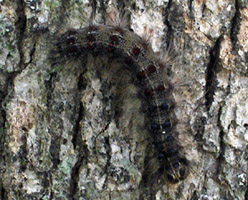NJDA GYPSY MOTH 2008 SUPPRESSION PROGRAM A SUCCESS
Increased Damage Seen in Forests, Less Damage in Spray Areas
For Immediate Release: July 14, 2008Contact: Lynne Richmond
(609) 633-2954
(TRENTON) – New Jersey Secretary of Agriculture Charles M. Kuperus today announced there was a slight increase in the damage to trees this year by gypsy moth caterpillars, however the rate of increase in the gypsy moth population in the state is showing signs of slowing down.
The New Jersey Department of Agriculture’s annual gypsy moth aerial defoliation survey showed 339,240 acres of trees defoliated in the state, as compared with 2007, when 320,610 acres of trees experienced leaf loss. In 2006, 125,743 acres were defoliated.
“Our gypsy moth aerial spray program to suppress the avid caterpillars is working in the towns that participated in the program,” said New Jersey Secretary of Agriculture Charles M. Kuperus. “We are seeing less damage in the areas that were sprayed and have seen a shift in the gypsy moth population from South Jersey to northwest areas of our state. We now will focus on the places that were not sprayed where the gypsy moths have spread.”
A total of 134 municipalities in 17 counties experienced defoliation – most of it heavy to severe – from gypsy moth caterpillars this year, compared with 19 counties and 124 towns last year with mostly severe damage. The hardest hit counties for a second year were Sussex and Burlington counties, however, Sussex County’s tree damage increased by 40,500 acres, while Burlington County’s decreased by 34,300 acres. Ocean County, which experienced the third highest number of acres damaged this year, also saw a decrease – from 50,000 acres last year to 44,200 this year.
Burlington and Ocean counties accounted for more than half of the acres sprayed for gypsy moth this year, with 23,904 and 24,098 acres, respectively. A total of about 94,000 acres in 17 counties, 78 municipalities, and 9 agencies were treated statewide with the insecticide Bacillus thuringiensis, or Bt. Bt is a non-chemical, “minimal risk” insecticide that only kills caterpillarsIt does not harm other insects, animals or humans.
Bergen and Morris Counties, which experienced small amounts of defoliation last year and participated in this year’s spray program, had no observable tree damage this year. Of the 17 counties with defoliation, eight had less damage than last year, seven had increases – mostly Northwest Jersey’s counties -- and two had about the same amount of defoliation.
“While Sussex, Burlington and Ocean Counties still account for the majority of the acreage of trees damaged this year by gypsy moth caterpillars, a large portion of the damage occurred on untreated state and federal woodlands,” said Carl Schulze, Director of the Department’s Division of Plant Industry, which conducts the Gypsy Moth Suppression Program. “A combination of our spray operation and increased numbers of parasites and predators released by the Department from 1967 to 1986 helped this year to slow the damage.”
The beneficial fungus disease, Entomaphaga maimaiga, which naturally kills off gypsy moth caterpillars, again had little impact on combating the gypsy moth. The fungus was present during the month of May, when there was enough rain to support growth of the fungus, however, June was dry, lessening the fungus’ impact.
“We will continue to work with municipal and state Department of Environmental Protection officials over the next several months on plans to continue to slow the spread of gypsy moth caterpillars,” said Secretary Kuperus. “Our goal is to prevent the loss of trees from gypsy moth damage and protect our forests, which not only are habitats for many animals but filter the air we breathe.”
This fall, municipalities with heavy infestations of gypsy moths, as delineated by this summer’s aerial defoliation survey, will be contacted and asked if they wish to have a gypsy moth egg mass count. This is done to determine if the infestation will continue and what areas qualify for the spray program. If the residential or recreational forest has an average of more than 500 egg masses per acre, and is at least 50 acres in size it may qualify for participation in the cooperative gypsy moth suppression program. Municipal participation in the aerial spray program is voluntary.
This year, the United States Forest Service provided $1,195,946 million in 23 percent cost reimbursement funds to municipalities participating in the Department of Agriculture Gypsy Moth Aerial Suppression Program.
Two to three consecutive years of significant defoliation (defined as 75 percent or more) can kill an otherwise healthy tree. However, any gypsy moth defoliation can make trees more susceptible to other damage that can lead to the death of the tree. Oak trees are the preferred host for gypsy moths, but the caterpillars can be found feeding on almost any tree in the vicinity.
In high populations, gypsy moths can blow 15 miles during storms, spreading into untreated areas. Each year, since 1970, gypsy moth caterpillars have caused varying degrees of defoliation -- between 1,910 and 800,000 acres of forested land. Past research has shown that repeatedly defoliated forests can expect oak tree mortality varying between 15 to 65 percent.
Last year’s defoliation resulted in the death of as many as 14,000 acres of trees due to consecutive defoliation by gypsy moth caterpillars.
To access the detailed 2008 New Jersey Gypsy Moth Aerial Defoliation survey and for more information on New Jersey’s gypsy moth suppression program, visit: www.nj.gov/agriculture/divisions/pi/prog/gypsymoth.html. Also, for national gypsy moth material, visit www.na.fs.fed.us/fhp/gm/.



